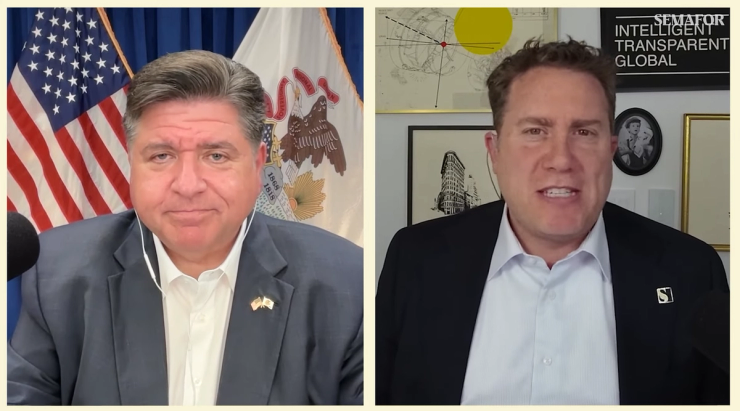The News
It’s become one of the defining experiences of modern politics, and it can happen to a foreign leader, a CEO, the governor of an American state: You wake up one morning and find yourself in the center of a social media storm in which Donald Trump has set the terms.
The form it takes is almost entirely visual. There are videos flying around, with or without context; the US government is producing some, promoting others from random X accounts. Dubious photos, winking AI jokes, and TikToks swallow facts and arguments, and Trump and his allies rapidly and cheerfully move from claim to claim. There is not a lot of emphasis on factual claims, press releases, forceful statements.
Illinois Gov. JB Pritzker has found himself in the center of a storm like that since the president announced last month that he would send National Guard troops to Chicago to protect immigration agents. Pritzker has been trying to debunk claims that Chicago is an out-of-control hellhole; to assert in court that the federal government has no right to send in federal troops; and to discredit the tactics by immigration agents to arrest migrants in his state’s streets and businesses.
Pritzker — who took a brief break from the information war (or perhaps he saw it as another front) to talk to Semafor’s media show, Mixed Signals, last week— has tried a lot of things. He’s gone to court and won a stay against deploying the National Guard (Trump has asked the Supreme Court to hear that case) and he’s held press conferences with a diverse array of local leaders who don’t want a federal presence in their city.
But Pritzker, unusual among Trump’s antagonists, has also begun to beat the White House at its own game — the visual, visceral, and at times post-literate politics of 2025.
His press office has taken to sending out text-free press releases composed solely of images of ICE agents pointing guns at civilians. He squeezed into a flak jacket to shoot a dispatch for Jimmy Kimmel from “war-torn Chicago.”
And most of all, he and his city have managed to drown out the story the White House is trying to tell with their own videos of ICE agents at work.
“I have asked everybody in Chicago: When they see ICE in the neighborhoods, pull your phone out, video everything, or send it to local media. And more and more, that’s exactly what’s happening. Virtually everything that people can video, they are now,” he said.
His government is also watching, he said, with “cameras from state police.” And a federal judge last week ordered federal agents to begin wearing their own body cameras this week.
Those scenes have overwhelmed the Department of Homeland Security’s slickly-produced videos depicting what appear to be well-trained, heavily armed agents conducting precise raids in military vehicles and helicopters. They show what appear to be poorly trained, sometimes out-of-shape agents losing footraces to their targets, ramming a moving car with an unmarked SUV, pointing weapons at protesters, and trying and failing to keep their masks on, all in the face of the obvious, vocal loathing of many Chicagoans who encounter them. (They compete with a parallel stream of videos from the right showing protesters screaming at federal agents, threatening them, and sometimes throwing things.)
In one particularly notable scene, a teenage girl yells that she’s not resisting as an agent pushes her to the ground. Department of Homeland Security’s Assistant Secretary for Public Affairs, Tricia McLaughlin responded dismissively on X: “Imagine being so desperate to demonize law enforcement you post a video from a burglary arrest Chicago Police made over a year ago.” But local journalists confirmed the video was of agents detaining a protester. McLaughlin has left the debunked video up, and didn’t respond directly to an inquiry as to why, but said in an email that “we stand by our statement.”
In this article:
Know More
Pritzker’s isn’t the only tactic Democratic governors are trying against Trump. California Gov. Gavin Newsom has met Trump’s outlandish all-caps tweets in kind, and is trying to escalate against the White House by, for instance, threatening to pull state funding from universities that try to negotiate with the administration.
“I enjoy the mocking that I read that he does,” Pritzker said. “But I have got to say, I have a different method. Maybe it’s because I’m a Midwesterner, maybe we just think differently here. And my own background makes me take this extremely seriously, what they’re doing on the ground. And I’m not suggesting anybody else isn’t, but just for me, it’s hard for me to make a joke out of much of it.”
Room for Disagreement
Those bystander videos rarely capture the White House’s perspective, though you can infer it: scared federal agents trying to do a legitimate federal duty, and one that a majority of Americans voted for and continue to support — deporting people who are in the US without proper papers. Pritzker has called the ICE deployment an “invasion.” McLaughlin said in a statement that “this is neither unconstitutional nor an invasion. President Trump has the authority under the Constitution to deploy troops, wherever they’re stationed, to defend federal facilities from attacks.”
I put this to Pritzker Thursday. He responded that “they have duties, but they’re carrying them out in ways that we’ve never seen. And they’re claiming that this is in an environment of ‘everything’s on fire and there’s murders on every street corner.’ They just have this overall narrative they’re telling and so I’m trying to debunk as much of that as I can.”
He added: When McLaughlin “says that I’m not giving proper respect — they’re not respecting the people of the city of Chicago, the people of Illinois, they’re not respecting our local law enforcement either.”
Ben’s view
Over the last two decades of accelerating digital politics, commentators are constantly pausing to observe that one party seems to have gained a permanent edge. Democrats dominated the early blogosphere, Trump owned Twitter and Facebook, and so on. Right now, there’s a broad consensus that the global populist right understands our almost post-literate new media in a way their opponents never will.
But the reality is that most 12-year-olds use their phones and TikTok accounts pretty effectively. It’s not that hard. The videos Pritzker has been encouraging would mostly be spreading anyway. In embracing those tools, Pritzker, an establishment Democrat who didn’t exactly begin his career as an influencer has come to represent what’s basically an inevitable evolutionary battle for political survival. The story of communications of the last two decades has been of constant change, and of nobody controlling the high ground for long.
The remaining question is whether Trump and his allies can retain an edge by purchasing and dominating digital platforms: by dialing X to 11, turning TikTok and CBS over to political allies, and stocking the White House press pool with friendly MAGA media outlets. I’d think the answer is probably no. As Trump’s success has proven, the efforts by the owners of a far more centralized media to contain his campaign and message backfired terribly. And as Pritzker is showing in Chicago, you can beat Trump at his own game, if you’re willing to play it.


